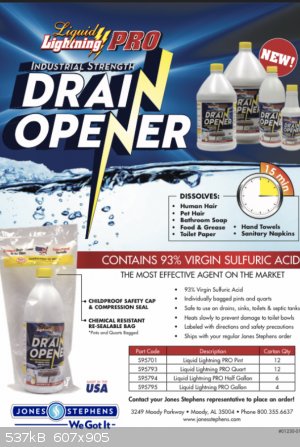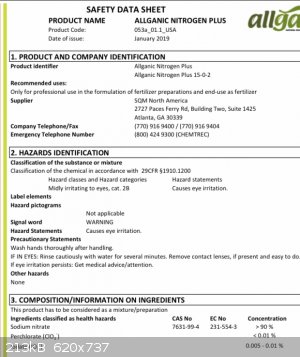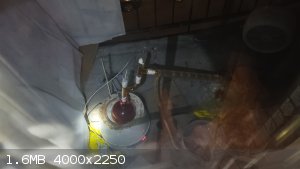Murcury
Harmless

Posts: 10
Registered: 28-11-2017
Member Is Offline
Mood: No Mood
|
|
Nitric acid questions
Hello all. Thank you for letting me in! I have started collecting computer parts to extract precious metals. I have decided that making my own nitric
acid is the way to go. Buying it is so costly, about $140/gallon and the chemicals used to produce it are really cheap, $16/gal H2SO4 andb$20/55lbs
NaNO2.
I’m not looking to make gallons, however, I would like to have it on hand so I don’t have to wait on a project for the nitric.
I have some labware I’ve collected over the years. I have a collection flask, condenser, the elbow that goes on the collection side, a
heater/stirbar... and a box of other things.
My questions are.....
On the boiler side, do I need a thermometer for distilling nitric or sulfuric acid? Or can I get away with just a 75 degree adapter without a
thermometer port?
For a boiling flask... does round bottom or flat bottom matter? And I was looking at 1L.... but noticed a lot of people are using 500mL... is a 1L
overkill?
If I do go with a thermometer ported elbow, what gasket material will actually survive nitric? I see some things telling me Viton will not... but that
is what comes with that piece.
I’ll post a picture of the exact equipment I have when I get home this evening.
|
|
|
pantone159
National Hazard
   
Posts: 590
Registered: 27-6-2006
Location: Austin, TX, USA
Member Is Offline
Mood: desperate for shade
|
|
I am pretty sure you need sodium NITRATE (NaNO3) not sodium NITRITE (NaNO2).
|
|
|
Murcury
Harmless

Posts: 10
Registered: 28-11-2017
Member Is Offline
Mood: No Mood
|
|
Dang fat fingers.... I meant nitrate not nitrite. “Chilean nitrate” to be exact.
|
|
|
Syn the Sizer
National Hazard
   
Posts: 600
Registered: 12-11-2019
Location: Canada
Member Is Offline
|
|
For nitric acid, a 75° adapter should be fine but make sure the 105° adapter has a vacuum takeoff port or your receiving flask is at least 2 neck
lots of NO2 gas will be produced, if you are using a thermometer adapter viton is the seal you want it is a fluoropolymer. But honestly I wouldn't use
a thermometer. For reaction flask, if you plan on pulling a vacuum a round bottom is a must, flat bottoms will most likely implode. Flask size is just
preference for the most part, I mean don't use a 1L flask to distill 100mL of liquid, I think 1L is fine.
You don't want leaks so grease all your joints with sulfuric acid, most normal greased will get eaten by and contaminate your acid. If you are routing
the NO2 produced into a secondary vessel to produce dilute acid be sure to use suck back prevention of some sort.
An alternate method will save your sulfuric acid by using sodium bisulfAte in place of the acid.
|
|
|
Murcury
Harmless

Posts: 10
Registered: 28-11-2017
Member Is Offline
Mood: No Mood
|
|
The 105 I bought does have a vacuum takeoff. I was smart there! I’ll would sodium bisulfate be cheaper? Maybe because pool season is ending I can
get a deal. I was planning on making about 500mL at a time then diluting down to about 35% for most things.
I never considered porting the gas to make more... that’s a great idea... what type of suckback prevention?
And.... should I be pulling a vacuum? I hadn’t planned on it....
|
|
|
Herr Haber
International Hazard
    
Posts: 1236
Registered: 29-1-2016
Member Is Offline
Mood: No Mood
|
|
If you've never done this distillation before a thermometer would help.
But if you watch enough videos, understand what you are doing AND if you are REALLY patient you can just very SLOWLY crank up the temperature and
collect pretty pure acid.
A nice touch to help with the escaping NOx is to submerge your collection flask in ice water. I've seen a suckback in a vessel that was producing NO2,
that should tell you how much it loves water so take Syn's advice seriously.
@Syn: in my experience grease will simply converted to CO2 by hot nitric acid vapor 
The spirit of adventure was upon me. Having nitric acid and copper, I had only to learn what the words 'act upon' meant. - Ira Remsen
|
|
|
JJay
International Hazard
    
Posts: 3440
Registered: 15-10-2015
Member Is Offline
|
|
If you do use a thermometer, it's a good idea to use a glass thermometer well - a rubber or plastic thermometer adapter will be damaged by the nitric
acid vapors and will probably not surive one distillation.
|
|
|
Tsjerk
International Hazard
    
Posts: 3032
Registered: 20-4-2005
Location: Netherlands
Member Is Offline
Mood: Mood
|
|
Of course learning how to do a distillation is priceless, but for dissolving metals from circuit boards you can just dissolve the nitrate salt in
diluted sulfuric acid to prepare the nitric acid in situ.
How are you planning to do the extraction?
[Edited on 26-8-2020 by Tsjerk]
|
|
|
Murcury
Harmless

Posts: 10
Registered: 28-11-2017
Member Is Offline
Mood: No Mood
|
|
I need nitric for aqua regia. And I’ll also be using it to remove silver from keyboard mylars. And test for gold and silver.
The materials are mostly gold plated pins and foils. I was going to use copper sulfate cell to strip the gold From the pins and AP for the foils then
AR to clean up.
|
|
|
Tsjerk
International Hazard
    
Posts: 3032
Registered: 20-4-2005
Location: Netherlands
Member Is Offline
Mood: Mood
|
|
If you add sodium chloride to the sodium nitrate/sulfuric acid you get a mixture of aqua regia and sodium sulfate.
The sodium sulfate shouldn't interfere downstream.
|
|
|
Murcury
Harmless

Posts: 10
Registered: 28-11-2017
Member Is Offline
Mood: No Mood
|
|
I’m going to use sodium metabosulfate to precipitate the gold.
Using the above.... can I use that for spot testing for gold?
|
|
|
Syn the Sizer
National Hazard
   
Posts: 600
Registered: 12-11-2019
Location: Canada
Member Is Offline
|
|
I guess it depends where you live and OTC availability. Drain cleaner grade sulfuric acid is harder to find in my city than bisulfate.
Quote: Originally posted by Murcury  |
I never considered porting the gas to make more... that’s a great idea... what type of suckback prevention?
And.... should I be pulling a vacuum? I hadn’t planned on it.... |
I like to use 2 flasks an empty one in the middle and the ice water in the last flask.
I should have worded the vacuum comment differently. What I meant is if you ever decide on pulling a vacuum on the flask during a different reaction
you will want RB.
Interesting, I am always concerned about contamination, but that does make sense.
|
|
|
Murcury
Harmless

Posts: 10
Registered: 28-11-2017
Member Is Offline
Mood: No Mood
|
|
Ok.... how do you post pictures here?
|
|
|
Tsjerk
International Hazard
    
Posts: 3032
Registered: 20-4-2005
Location: Netherlands
Member Is Offline
Mood: Mood
|
|
If you click on preview post you can upload files. If it is an image the forum software will recognize it as such. Just make sure the size of the
image fits the normal width of the screen. You can check by clicking preview again.
|
|
|
Murcury
Harmless

Posts: 10
Registered: 28-11-2017
Member Is Offline
Mood: No Mood
|
|
This is the acid. Walmart has it for $16.
And the fertilizer is $20.


|
|
|
woelen
Super Administrator
        
Posts: 8012
Registered: 20-8-2005
Location: Netherlands
Member Is Offline
Mood: interested
|
|
If you have NaNO3, then the simplest is to dissolve this in concentrated hydrochloric acid (30% or better). If you can get conc. H2SO4 then I'm sure
that you also can get conc. HCl.
Use HCl of high concentration, the higher the better. Dissolve the NaNO3 in boiling hot water, to make a really concentrated solution. In 100 ml of
boiling hot water you can dissolve well over 150 grams of NaNO3. Add this solution to 150 ml of ice cold conc. HCl. A lot of NaCl will precipitate and
you get aqua regia (with some left over NaCl/NaNO3 in it, which does no harm). What you get is not the optimum aqua regia (it will be somewhat low in
nitrate), but it will be good enough to dissolve the metal. It is better to have sufficient acid in it than having a high nitrate content with only
little acid.
Do the addition of the hot solution of NaNO3 to the acid outside. Because of the high temperature of the NaNO3-solution, the solubility of the HCl
will decrease and you may get a lot of fumes of HCl. You don't want those fumes inside. For this reason it is best to make the acid as cold as
possible. Freezer-cold (-18 C or so) is best.
[Edited on 27-8-20 by woelen]
|
|
|
Murcury
Harmless

Posts: 10
Registered: 28-11-2017
Member Is Offline
Mood: No Mood
|
|
That is way easier for AR! But processing the mylars I think nitric would be the best bet still right?
|
|
|
Herr Haber
International Hazard
    
Posts: 1236
Registered: 29-1-2016
Member Is Offline
Mood: No Mood
|
|
Yes
You could literally distill RFNA (which would be ideal for all the organics) and use it directly in a reaction vessel with your broken up cpu's,
memories, pins etc.
No storage, no worries.
Though it wont dissolve gold it might dissolve other metals that you are after so their recovery can be another issue.
You'll end up with gold in gunk.
I dissolve silver in a reaction vessel and have a lot of gunk at the bottom of it after a couple uses (I just leave it there to collect).
All the gunk is not gold unfortunately. After emptying the reactor as much as possible I treat this gunk with concentrated or fuming acid
episodically. When done, the volume is usually much lower.
The spirit of adventure was upon me. Having nitric acid and copper, I had only to learn what the words 'act upon' meant. - Ira Remsen
|
|
|
Murcury
Harmless

Posts: 10
Registered: 28-11-2017
Member Is Offline
Mood: No Mood
|
|
I was told I could possibly buy the couple pieces of labware I need to finish my distillation setup here. I’ll look around for that. Hopefully I
can get some of these projects done soon!
Thank you for helping me figure out the best route.
|
|
|
B(a)P
International Hazard
    
Posts: 1139
Registered: 29-9-2019
Member Is Offline
Mood: Festive
|
|
Avoid plastic joint clips, nitric acid destroys them. You might get one distillation out of them, but then they just disintegrate.
|
|
|
IrishJeremy
Harmless

Posts: 11
Registered: 12-11-2019
Member Is Offline
|
|
I'm currently making some fuming nitric acid, I'm using a brand of drain cleaner sulfuric acid that is new to me and things are going REALLY slowly.
The bottle of acid mentions that it contains inhibitors, does anyone know what they might be, and if they might be interfering in the acid production
process? It's about 17c outside today so I'm also concerned that the issue might be the temperature. I have the reaction flask sitting in a hot water
bath with my hotplate under it. I'm using kno3 as my nitrate salt. Any help would be greatly appreciated, thanks!
|
|
|
ManyInterests
National Hazard
   
Posts: 930
Registered: 19-5-2019
Member Is Offline
|
|
Quote: Originally posted by IrishJeremy  | | I'm currently making some fuming nitric acid, I'm using a brand of drain cleaner sulfuric acid that is new to me and things are going REALLY slowly.
The bottle of acid mentions that it contains inhibitors, does anyone know what they might be, and if they might be interfering in the acid production
process? It's about 17c outside today so I'm also concerned that the issue might be the temperature. I have the reaction flask sitting in a hot water
bath with my hotplate under it. I'm using kno3 as my nitrate salt. Any help would be greatly appreciated, thanks! |
From what I've seen in the videos by the CanadianChemist using drain cleaner grade sulfuric acid will not affect your final product that much. They've
all used that stuff and the results worked just fine. The inhibitors will be left behind in the waste after the distillation is done.
I could be mistaken about that. Anyone with any experience can maybe correct me? NileRed and Nurdrage also have videos on fuming HNO3 but they used
98% H2SO4.
I don't know about the heat outside, but I don't think it is that much of an issue. I purified some sulfuric acid today by boiling it. It was roughly
that temperature as well and it did not affect my end product. I have some extremely pure H2SO4 in a nice erlenmeyer flask
KNO3 will work fine. I don't think the actual type of nitrate matters that much so long as you're using a fairly pure nitrate.
I think you'll need more heat to make the reaction work. I've seen oil baths instead of water baths. I'll post some videos that should aid in the
process.
While I am at this I have a question about the bottles for storing fuming nitric acid. Can I store them in a tinted liquor bottle? It isn't
borosilicate or chemistry grade, but will the nitric acid attack the glass bottle?
|
|
|
Fyndium
International Hazard
    
Posts: 1192
Registered: 12-7-2020
Location: Not in USA
Member Is Offline
|
|
Using calcium nitrate causes a solid mass of calcium sulfate formation. Adding even quarter of water soluble nitrate makes it's extraction after
reaction 10 times easier.
|
|
|
LabDIRECT
Harmless

Posts: 49
Registered: 3-5-2021
Member Is Offline
|
|
I second the Calcium Nitrate - definitely better. But we can probably get you ACS grade 70% Nitric acid for about the same price and with much less
effort. LabDirectLLC.com - send me an email at richard.carboni at labdirectllc.com and I'll make sure to do whatever we can to help out a first time
customer
|
|
|
ManyInterests
National Hazard
   
Posts: 930
Registered: 19-5-2019
Member Is Offline
|
|
I decided to bump this old thread because I have some questions regarding making nitric acid.
In times past, I played it by ear, since I couldn't control for temperature. Now I got a thermometer adapter and a clairsen adapter, I decided to try
it out and set my temperature at no more than 90C. But I am not seeing that much acid coming over. Does making WFNA normally take this long? Or is
simply the acid cooling down too quick and returning to the flask?
For a note, it is currently in process?

|
|
|
Texium
|
Thread Moved
12-9-2023 at 11:52 |